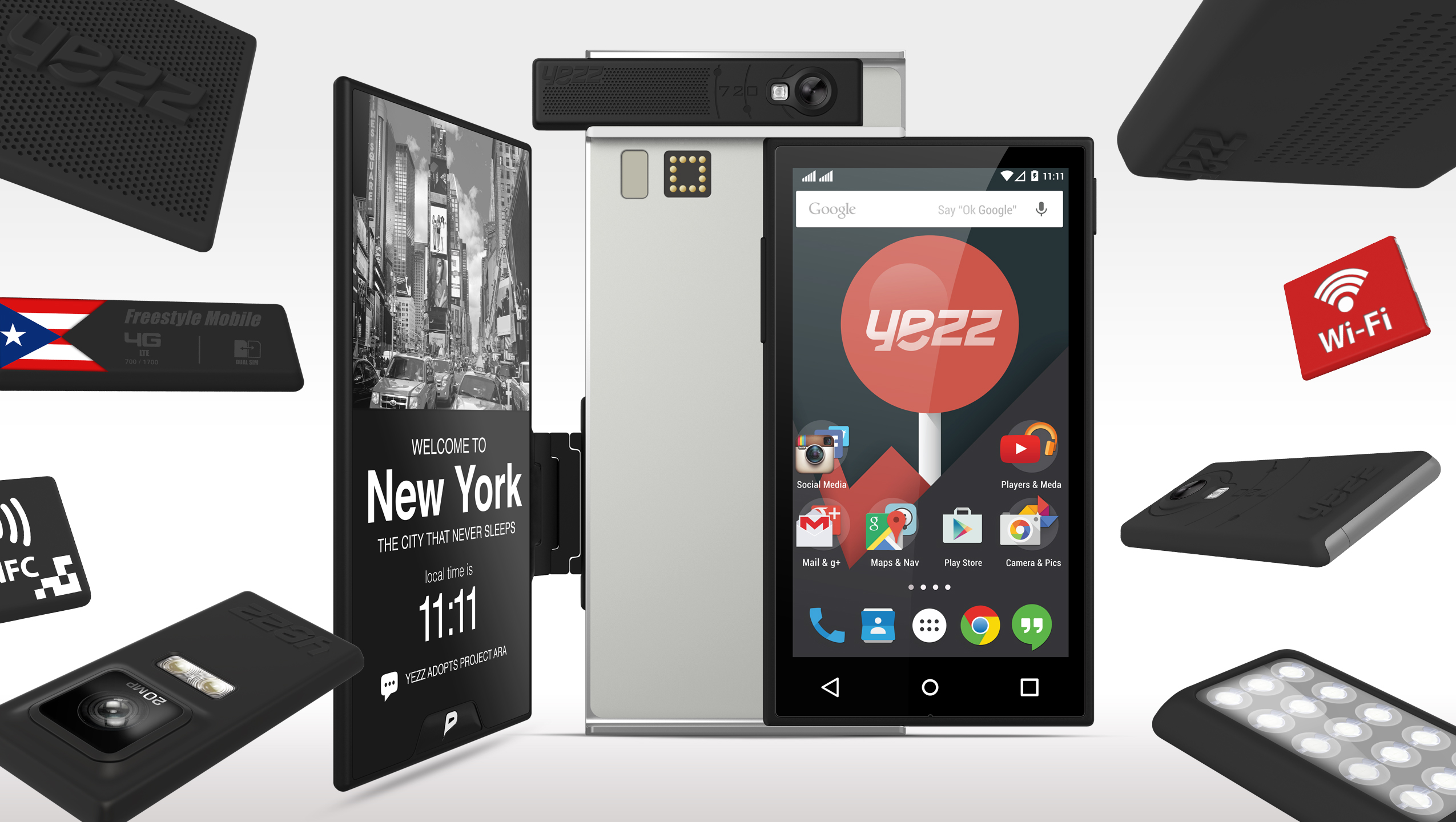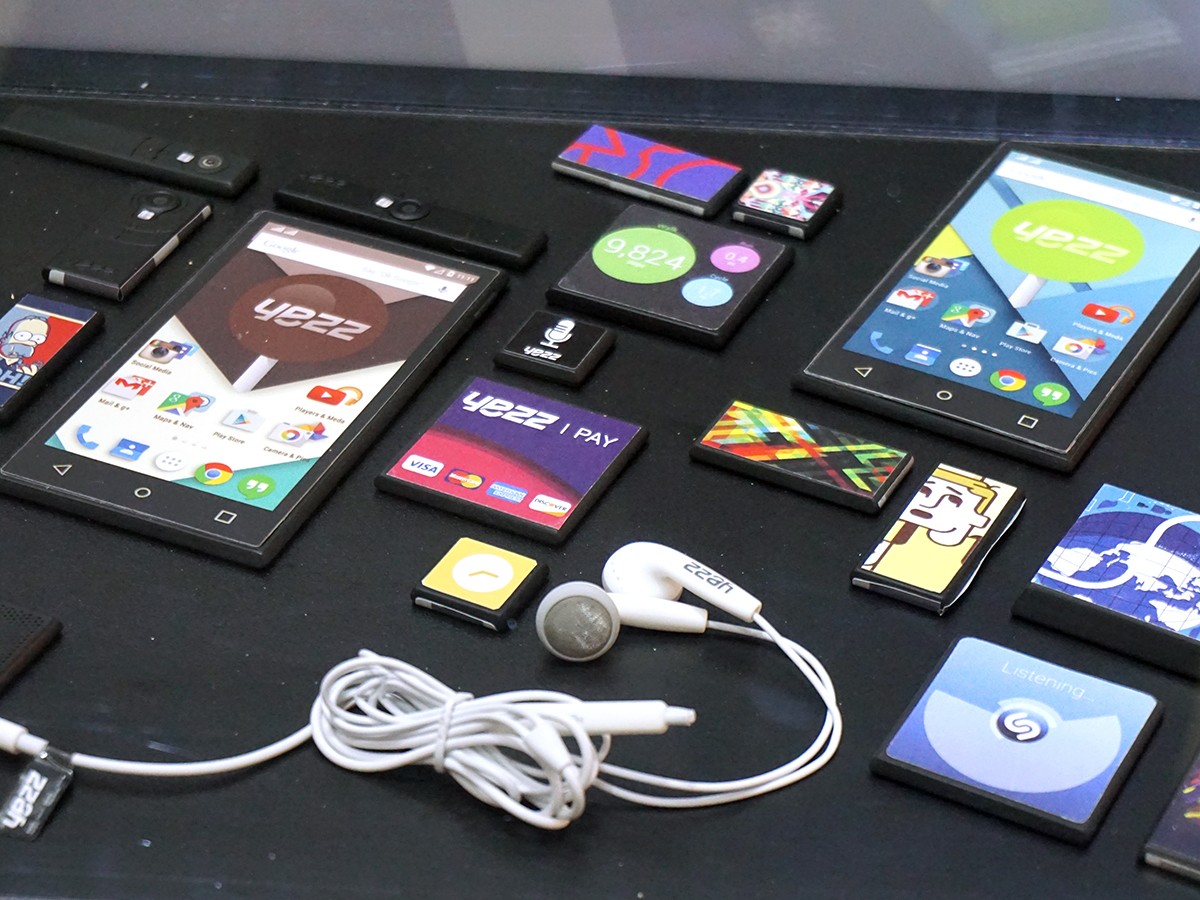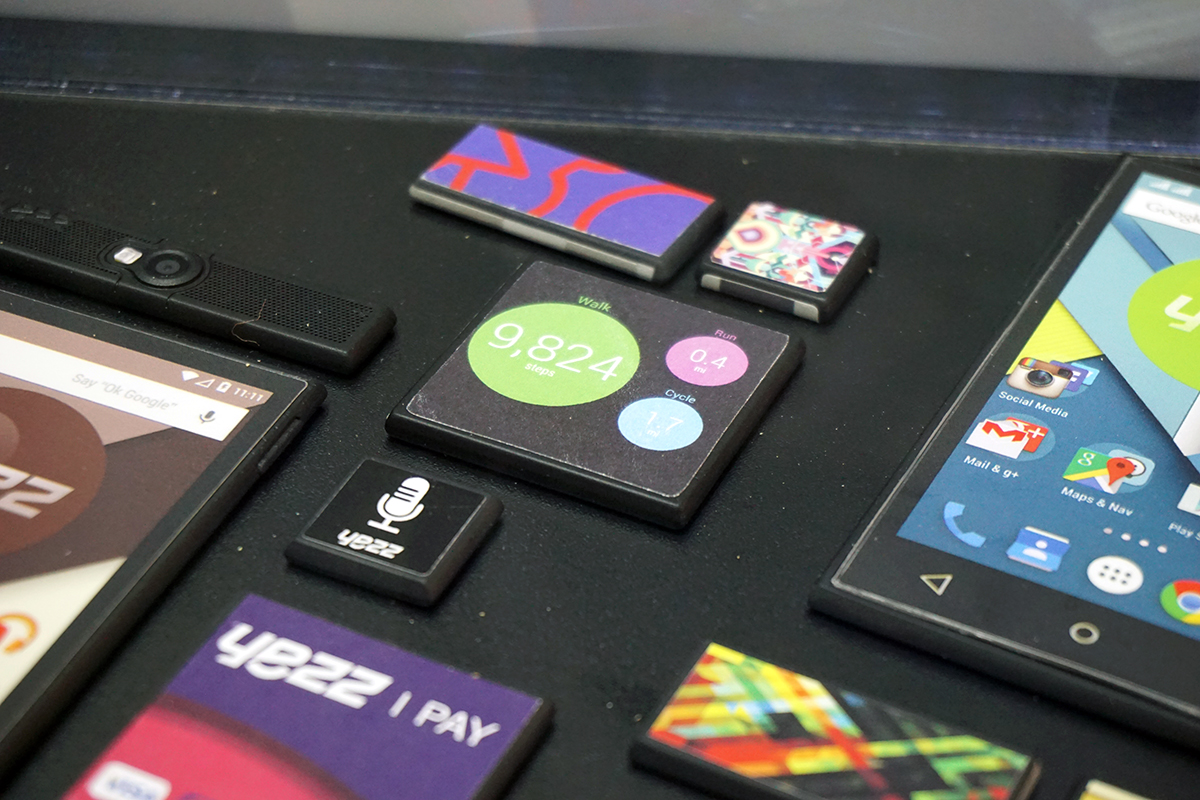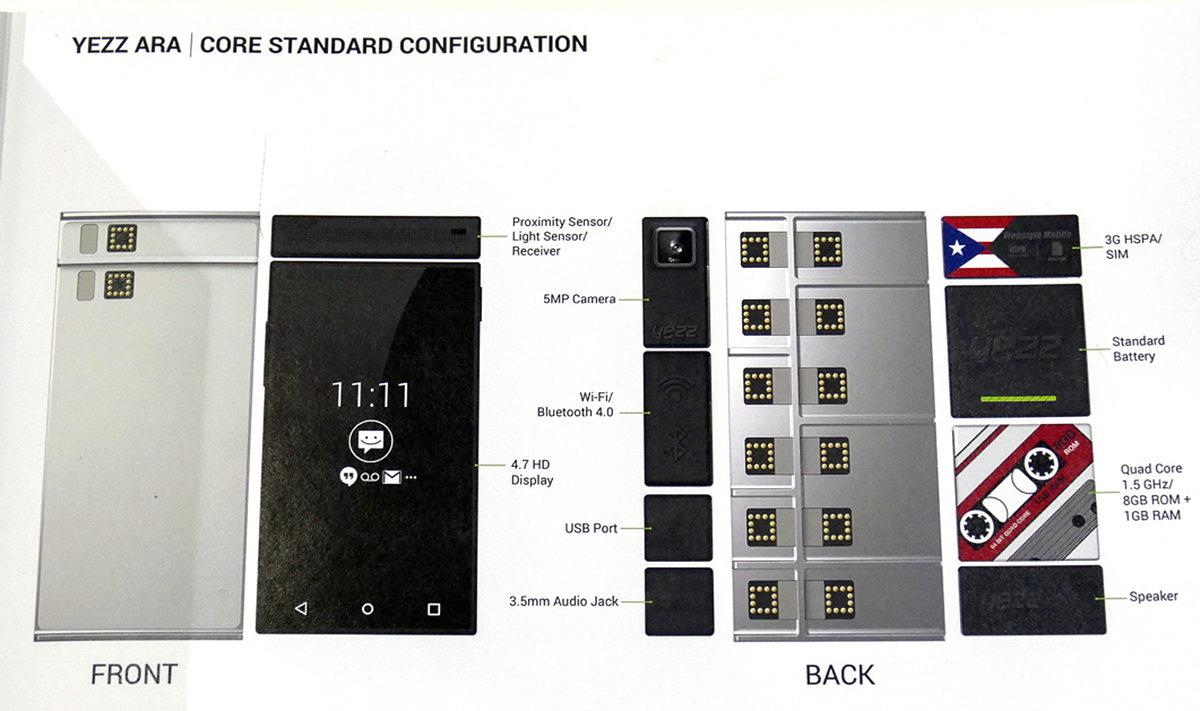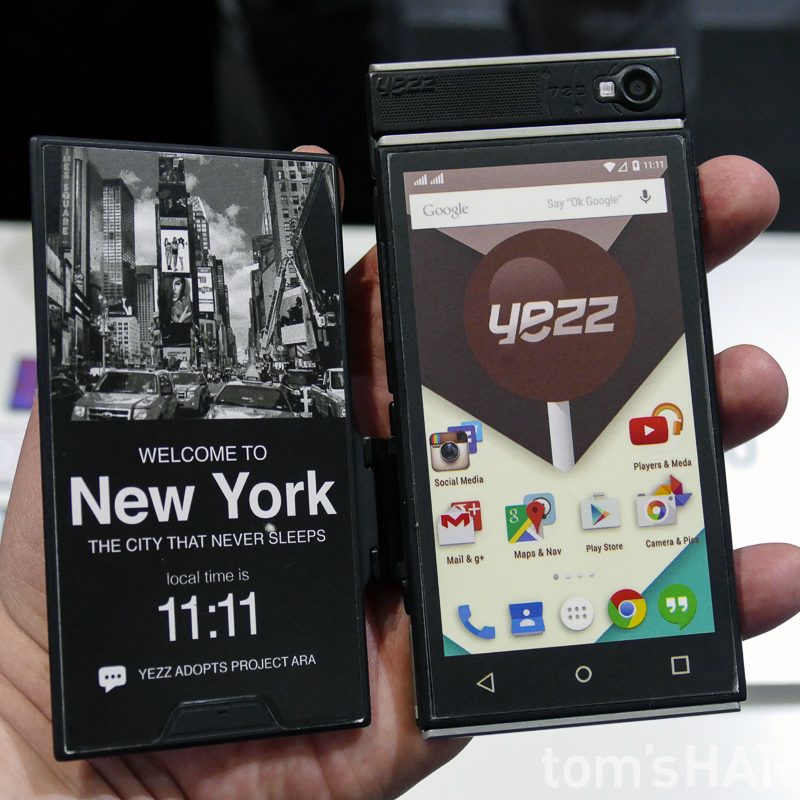Google Taps Yezz For First Project Ara Modules, Working Smartphone Coming Spiral 3 (Updated)
Yezz just might be one of the most important tech companies you've never heard of.
The company has been sending out teaser emails ahead of MWC 2015 saying vague things such as "Yezz has adopted Project Ara," which could mean anything, really. We visited the Yezz booth at MWC to see what exactly is the big deal, if anything.
Yezz showed us copious mockups of modules, as well as a pretty 100-page design book full of sketches of possible modules. The Yezz team also had a mockup of an Ara Endo replete with flashy modules. It was all just paper and plastic, and to be frank, we were a bit skeptical. We've seen plenty of plastic Project Ara-related mockups, and we're not at all excited about them at this point.
I was smelling the familiar foul, metallic scent of vaporware until Yezz' Maurizio Sole Festa, VP of Marketing, told us that the hardware prototypes are real. It turns out that the company was actually underplaying its hand with those vague emails.
Yezz is making modules for Google's Project Ara modular smartphone initiative.
The Real Deal
The company is designing some of the hardware inside of the modules, but it's also an OEM, manufacturing its own modules as well as the designs of other companies. For example, Festa told us that although Toshiba designed and showed off some camera modules, with the full reference design laid out, it's Yezz that will be making them.
"This is my Darth Vader," said Festa, holding up a module with Lord Vader's visage printed on the back. "This is exactly what our designer has designed for gaming. So the idea is that this is a super video card...and then my phone [would be] perfect [for] gaming."
Get Tom's Hardware's best news and in-depth reviews, straight to your inbox.
Of note is the fact that Yezz is looking at building a small game controller that would slot into the Endo. He further noted that if you are a gamer and pop in a discrete GPU module, you could opt for a battery module with much greater capacity.
He said that Nvidia would ostensibly hand over core reference designs, and Yezz will manufacture it -- "it" meaning a discrete GPU, in the form of a module. An Nvidia GPU module is not something that's set in stone, he said, and he also noted that Google would be the one to ultimately make those sorts of deals.
Yezz is very much in tight with Google. It doesn't appear that Yezz is technically part of Project Ara within Google ATAP (the marketing materials are perhaps overstating that part, but it's unclear), but it is the de facto module maker for the Project Ara initiative and pilot launch in Puerto Rico.
It might not mean much in the long run -- it's impossible to predict how these things will shake out -- but a note in the history of Project Ara is the fact that Yezz is the first Project Ara module OEM.
That's an enormous coup for the small company, and it's an opportunity to take early control of what could be a hugely important market -- one that could ostensibly create an entire (large) cottage industry of module makers and accessorizers. This is because the concept of a modular smartphone with discrete, upgradable components is the exact paradigm of the home-built PC. A Project Ara phone will be an enthusiast-class device.
For PC enthusiasts, it should be refreshing to see so much freedom in a smartphone platform. "There's no two individuals that are exactly the same, and I do believe that's why this technology is important," said Festa.
For Yezz' part, although Festa shared plans for the near future that bordered on the grandiose (hey, he is the VP of Marketing, after all), there are some very specific, concrete plans, as well. There will be at least ten modules ready to go by the launch of Project Ara's Spiral 3 (exactly enough to completely fill all the slots on an Endo) later this year -- eight for the back of the device and two for the front.
The company took things a step further by illustrating what the first Ara phone could look like, equipped with those ten modules.
Yezz calls it the Core Standard configuration.
The First Project Ara Phone: Yezz' "Core Standard" Configuration
It's odd that such an important image is just sitting there, in a physical paper book, but there you have it.
The front of the device has two module slots -- a small one at the top and one that's larger; these will be filled by a proximity sensor/light sensor/receiver and a 4.7-inch HD display, respectively. According to the mockup, you'll be able to see notifications and the time on the lock screen, which looks exactly like Motorola's Active Display feature.
The rear will include a 5 MP camera module, Wi-Fi/Bluetooth, a USB port, a 3G HSPA/SIM module and a "standard" battery. The bottom 1 x 2 module is reserved for a speaker, and there's a 2 x 2 module that will be the standard, basic APU, which is a quad-core (1.5 GHz) chip with 1 GB of RAM and 8 GB of storage.
There's an entire module (just a 1 x 1) solely for the 3.5 mm audio jack. It's interesting to see that so much real estate is occupied by that one port; you have to wonder if a more clever configuration could include the headphone jack with another module.
Yezz showed us additional conceptual drawings of possible configurations, although Festa said that these models were still just concepts at this point, with no solid plans for development yet.
One of those, the "Add On Module" configuration, includes a little notification bar on the front and top of the Endo. On the back, wild module ideas abound, such as an LED-packed flashlight powered by Energizer, a far more powerful and spacious SoC (2.3 GHz quad-core, with 2 GB of RAM and 128 GB of storage), an extended battery, a fingerprint reader, a breathalyzer, and a breath strips dispenser. (Repeat: A breath strips dispenser.)
It also sports a leather flip cover that uses an E-ink secondary display with solar charging capabilities baked in. (While you're dreaming, dream big, right?)
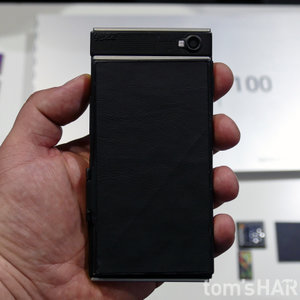

Festa stated unequivocally that the Core Standard configuration will be a real product that you will be able to buy, just as soon as Google completes its trials, finalizes details and greenlights the official launch. (Google, Festa told us, is very much in the driver's seat here. But he noted that Project Ara is a project, after all -- a collaboration -- and Yezz is part of making Project Ara a Real Thing; some of those details of which company does what will be sorted out later.)
An incredible part of this story is how quickly Yezz came into the picture. We did not, for example, see Yezz at CES, and that's because the company wasn't showing anything particularly compelling at that time; its involvement in Project Ara, and thus its impressive development, came after. It's been less than two months in the making.
Timeline
Despite the startlingly short lead time, when Project Ara launches in Puerto Rico, Yezz will have working modules that will form a fully operational phone. That phone, as noted above, will be the Core Standard configuration model.
When asked how far along Yezz is in the process of making these modules, Festa said, "All the reference design is laid out, so I think after Spiral 3 is completed, we will be able to proceed with final testing and mass production."
He added, "We're already working with development boards, and we're already blowing out fuses." (At this we all chuckled.) "Google has provided us boards for our engineer to start testing a micro version of the circuits, and once we finish, we will integrate and lay everything into a PCB [that is the] actual size of the modules."
"For us, on the phone, this takes anywhere between 75 to 120 days, according to the extent and complexity of the project. With the downloadable MDK and the development website, Google has already handed over to us an incredible amount of work."
There's no guarantee that Project Ara will ever make it past (or even to) the pilot launch in Puerto Rico, but if things continue to work out on Google's end, it appears that Yezz will be ready with a pile of working modules and the first Project Ara smartphone.
Update, 3/5/15, 2:45am PST. We have spoken again with Yezz and are updating this article for clarity: Yezz is by no means an exclusive OEM for Project Ara; the MDKs are available to anyone who wants to use them. Google has not partnered specifically with Yezz in any way, any more than it may have and/or will work with any other company that plans to manufacture modules for Project Ara.
Yezz is using the Project Ara MDK reference designs to make its first round of modules for the Core Standard configuration.
We referenced the fact that Yezz will build a module based on Toshiba's camera module reference design, which is true, but that design is open to any module developer; it's not as if Toshiba has contracted Yezz to be its OEM.
Yezz confirmed that it is not part of ATAP. It is simply a company that is diving into making modules for Project Ara.
Regarding the pilot launch in Puerto Rico (Spiral 3) and Yezz' involvement, I failed to accurately paint that picture; put simply, Yezz plans to support Project Ara's pilot launch in Puerto Rico, and that's as far as any statement on the matter goes at this point. The pilot launch will begin by the end of 2015.
We regret any misunderstandings in this matter.
Follow Seth Colaner @SethColaner. Follow us @tomshardware, on Facebook and on Google+.
Seth Colaner previously served as News Director at Tom's Hardware. He covered technology news, focusing on keyboards, virtual reality, and wearables.
-
tastyKake It's nice to see actual specs floating around but come one, a cheap plastic mockup with children's stickers that are well worn is how you present this? It's no different than any renders they've released. I want to see this project succeed but I'm getting tired of these "hang-on" news releases.Reply -
Gunbuster oh boy, they have added a Darth Vader and cassette tape sticker to round out the golden retriever and rainbow modules. Cant wait to buy one of these at the corner liquor store or 7-11Reply -
torka "which looks exactly like Motorola's Active Display feature. "Reply
What you meant was, that it looks exactly like Nokia's Glance feature. -
scolaner ReplyIt's nice to see actual specs floating around but come one, a cheap plastic mockup with children's stickers that are well worn is how you present this? It's no different than any renders they've released. I want to see this project succeed but I'm getting tired of these "hang-on" news releases.
You and me both. That's why this is exciting: Although Yezz didn't have any prototypes to show, they are making them. Real products. That's a big step forward for this project.
